
The Deck That Doesn’t Die - Yamata OTK Deck Profile
Dylan Hunt
July 27, 2015
Important Note: This article was posted before the official errata of Ritual of Millenia. The errata greatly changes the card, making it no longer function properly in this deck. Although still a powerful deck, this is enough to cause me to rethink a lot of design choices made in its construction.
Hello everyone. Once again I’m Dylan Hunt, this time doing a profile on a deck that has been stirring up a lot of excitement in my local community. But before I get started telling you about the deck, I need to explain the deck that inspired it. If you want to go directly to the deck, feel free to skip the next section.
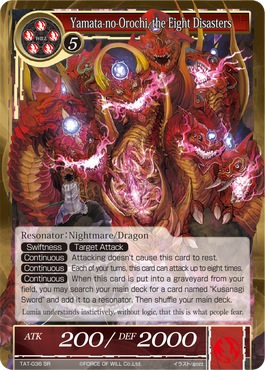
Yamata is a pretty scary resonator, able to attack 8 times in a single turn without resting, and thanks to Target Attack and Swiftness, it has the choice of attacking any other resonator the turn it is played and still block during the opponents turn. Such a massive body isn't without its price though, Yamata costs a whopping 5 fire will and 5 generic, rounding out to a total cost of 10 (the highest of any resonator). Luckily, MPR brought out a card to bring the legendary creature to your field several turns earlier then normal, allowing it to be a competitive card. 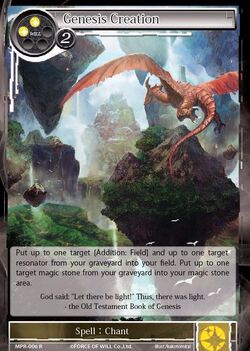
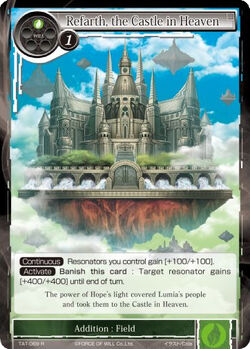
With Genesis Creation, not only could Yamata be brought out as early as turn 4, you could also bring out a field addition like Refarth to boost its attacks to be strong enough to end the game in a single turn. This lead to the creation of a deck based on this theme, often referred to as "salt.deck". Utilizing cards like Knight of the New Moon, Forty Thieves and Card Soldier "Club", the player would send Yamata and Refarth to the graveyard so that they could quickly be brought to the field by Genesis Creation. Although promising, the deck had numerous shortcomings due to the amount of time it took to setup and the amount of resources the combo occupied in the deck. Cards like Elvish Priest could help accelerate the deck a turn, but cards like Thunder and Rapid Decay could wipe it from the board, setting the salt player back a turn they couldn't afford to spare. Even worse Xeex the Ancient Magic could empty your graveyard entirely, undoing all the turns of setup required to enable the play, and Absolute Cake Zone was able to cancel the Genesis Creation and leave you vulnerable to your opponent without anything to show for it. Salt was quickly swept under the rug as control decks rose in popularity, a distant memory in the minds of players. But not for long. Although salt failed to establish a meta presence, it did prove that the concept of resurrecting a high cost resonator was a viable win condition, it just needed to be much faster then the deck was actually able to perform. Taking that into consideration, work was put into creating a new deck around the concept, utilizing new cards from MOA.
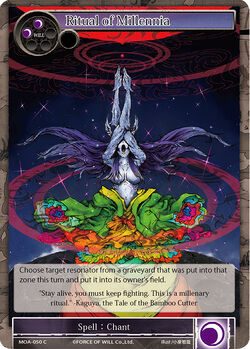
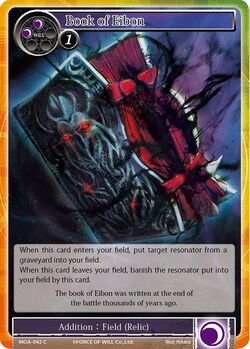
MOA brought two notable cards into the concept of resurrecting resonators: Ritual of Millennia and Book of Eibon. With two more options the deck is now much more viable, gaining the ability to play Yamata (or another high cost resonator) as early as turn 2 (much faster then your opponent will be able to prepare), allowing you to ignore cards like Xeex and Cakezone. Ritual can be utilized quickly by using the ability of Knight of the New Moon before your stand phase, allowing you to draw a card and discard Yamata which can then be brought back by Ritual. Book of Eibon presents the option of reviving Yamata turn 3 without having to discard him that turn, as well as a powerfull combination with Genesis Creation where you are able to bring back up to 2 resonators, allowing for up to 2 Yamatas to be summoned, dishing out an astonishing 16 attacks. Refarth remains a strong contender but is no longer required in order to finish the game in a single turn, as you can take advantage of the low cost of Ritual to play Evolution of Limits the same turn, allowing you to hit for even more damage then before. Although not from MOA, the new Dual Starter Deck brings Guinevere, the Jealous Queen, yet another way to trigger Ritual and allow the summon of our 8 headed friend. With all the different colors utilized in the deck, it's likely you were wondering how it's possible to play so many different cards within the first turn. Thankfully, that question is answered by salt.deck, which utilized Liberator of Wind as a ruler in order to stack Magic Stone of Moon Shade on top of the stone deck. Complementing this is 4 copies of Magic Stone of Moon Light, allowing us to generate any color of will (thanks to Moon Shade). If the game drags on without drawing a combo piece (or if a card like Law of Silence is used to stop you from playing any that turn), you can also J-Activate to search one out.
Now that I've finished explaining the deck, here is the decklist that I've been working on. There is likely some cards that can be fine tuned further, but playtesting has proven the deck to be extremely promising, even against the new fire support. Due to the themes of fragile resonators summoning dragons, I've opted to call the deck "Dragonborn" (AKA Salt 2.0)
Ruler:
Liberator of Wind/Scheherazade, the Teller of 1001 Stories
Deck:
4 Guinevere, the Jealous Queen 4 Knight of the New Moon 3 Elvish Priest 4 Card Soldier "Club" 4 Forty Thieves 1 Susanowo, the Ten-Fist Sword 4 Yamata-no-Orochi, the Eight Disasters 2 Evolution of Limits 4 Ritual of Millennia 2 Refarth, the Castle in Heaven 4 Book of Eibon 4 Genesis Creation
Stone deck: 4 Magic Stone of Moon Light 4 Magic Stone of Moon Shade 2 Magic Stone of Scorched Bales



